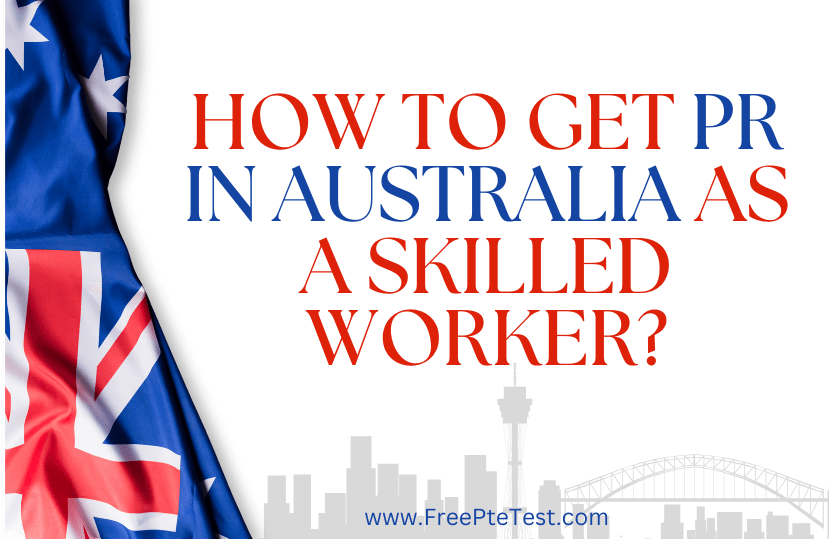Securing PR in Australia as a skilled worker is a life-changing opportunity, offering access to a wealth of benefits and an exceptional quality of life.
With its high demand for skilled professionals across diverse industries, Australia remains one of the top destinations for ambitious individuals seeking long-term career growth and stability.
The recent updates to Australia’s skilled visa program, which came into effect on December 7, 2024, bring a host of improvements aimed at simplifying the migration process while targeting the skills most urgently needed.
Central to these changes are the introduction of the Core Skills Occupation List (CSOL) and the launch of the Skills in Demand (SID) visa, replacing the Temporary Skill Shortage (TSS) visa.
These developments aim to streamline pathways to PR, providing clarity and certainty for migrants and employers alike.
Today you’ll learn everything you need to know about the Australian PR process for skilled workers, explore the updates to visa programs, and gain insights on how you can leverage these changes to build a successful future in Australia.
What is the process for PR in Australia for Skilled Workers?
The process of obtaining Australian PR as a skilled worker involves several key steps. Read on the detailed breakdown of what you need to know:
Step 1: Verify Eligibility
The first step is determining your eligibility for the relevant skilled visa categories. Australia’s skilled migration program is based on a points-tested system. Key eligibility criteria include:
- Age – You must be under 45 years of age when you apply.
- Skills Assessment – Your qualifications and work experience must be positively assessed by a relevant assessing authority for your nominated occupation.
- English Proficiency – You’ll need to meet minimum language requirements, typically demonstrated through tests like IELTS or PTE.
- Work Experience – Specific visa categories, like the SID visa, require one to three years of relevant work experience, depending on the stream.
- Points Test – Points are awarded based on factors such as age, education, work experience, and language skills. You must meet the minimum score threshold (usually 65 points).
Step 2: Choose the Right Visa Stream
With the updates effective from December 2024, skilled workers can choose from visa pathways under the Skills in Demand (SID) framework:
- Core Skills Stream – For occupations on the CSOL, meeting targeted workforce needs.
- Specialist Skills Stream – For high-earning individuals contributing to innovation and productivity.
- Labour Agreement Stream – Soon to be replaced by the Essential Skills Stream, tailored for agreements between employers and the government.
Alternatively, you may pursue PR directly through programs like the Employer Nomination Scheme (subclass 186).
Step 3: Submit an Expression of Interest (EOI)
To be invited to apply for a skilled visa, you must submit an Expression of Interest (EOI) through the SkillSelect platform.
Ensure your EOI accurately reflects your qualifications, skills, and experience to improve your chances of receiving an invitation.
Step 4: Receive an Invitation and Apply
If your EOI is successful, you’ll receive an invitation to apply for a skilled visa.
From the date of the invitation, you typically have 60 days to submit your complete application, including required documents like proof of identity, skills assessment results, and financial evidence.
Step 5: Await Decision
After submission, the Department of Home Affairs will review your application. Processing times vary depending on the visa stream and demand.
During this period, you may be asked to provide additional information or undergo medical examinations.
Step 6: Obtain Permanent Residency
Once your application is approved, you’ll receive your PR visa, granting you the right to live, work, and study in Australia indefinitely.
Latest Updates on Australian PR Visas
The Australian skilled migration program has recently undergone significant changes aimed at addressing the nation’s evolving labor market needs.
As of December 7, 2024, two major updates have been introduced:
Core Skills Occupation List (CSOL)
The CSOL replaces the previous multiple occupation lists used for visas like the Temporary Skill Shortage (TSS).
It consolidates more than 450 occupations across high-demand sectors such as construction, agriculture, healthcare, and cybersecurity.
Developed through rigorous labor market analysis by Jobs and Skills Australia, the CSOL is exclusively used for:
The Skills in Demand (SID) visa (Core Skills stream)
The Employer Nomination Scheme (subclass 186) (Direct Entry stream).
This change simplifies the selection process, making it easier for you to identify eligible roles that align with Australia’s economic priorities.
Skills in Demand (SID) Visa
Replacing the TSS visa, the SID visa (subclass 482) offers:
- A streamlined process for skilled workers and employers.
- A validity of up to four years.
- A direct pathway to permanent residency, with any work done for an approved employer contributing to your PR eligibility.
Key Streams of the SID Visa
- Core Skills Stream – For occupations on the CSOL, offering reduced work experience requirements and a salary threshold starting at AUD 73,150.
- Specialist Skills Stream – For highly skilled individuals earning at least AUD 135,000 annually, emphasizing innovation and productivity.
- Labour Agreement Stream (to be replaced by Essential Skills Stream) – Tailored for specialized agreements between employers and the government.
These updates reflect Australia’s commitment to welcoming skilled professionals while providing clarity and certainty about pathways to PR.
Key Factors Affecting PR Eligibility
Securing Permanent Residency as a skilled worker depends on several critical factors. Understanding these can help you navigate the process more effectively:
- Points Test
Australia’s skilled migration system relies on a points-based framework, where points are awarded for:
- Age – You earn the highest points if you’re between 25 and 32 years old.
- English Proficiency – High scores in English tests like IELTS or PTE can boost your points.
- Work Experience – Points increase with relevant skilled work experience, especially in your nominated occupation.
- Education – Higher education qualifications, particularly those obtained in Australia, are highly valued.
- Other Factors – Additional points can be earned for regional study, partner skills, or state/territory nomination.
You must achieve at least 65 points to be eligible, though higher scores increase your chances of receiving an invitation.
- Skills Assessment
A positive skills assessment by a relevant authority is mandatory. This verifies that your qualifications and work experience meet Australian standards for your occupation.
- Occupation List Eligibility
Your occupation must be listed on the relevant list, such as the CSOL. Regularly updated, these lists target skills that are in high demand within Australia.
- English Language Proficiency
Meeting or exceeding the required English language standards is essential. Most visas require a score equivalent to “Competent English,” though higher proficiency is often preferred.
- Work Experience
The SID visa, for example, requires only one year of work experience in your nominated occupation or a related field, which is less than the previous TSS visa requirements.
- Employer Sponsorship
If you pursue a visa requiring employer sponsorship, such as the SID or subclass 186, you’ll need to secure a job offer from an approved employer.
Tips for a Successful PR Application
To maximize your chances of success, consider these practical tips:
- Research Thoroughly
Stay updated on the latest immigration policies, occupation lists, and visa requirements.
Use official resources like the Department of Home Affairs website or consult with registered migration agents.
- Choose the Right Visa Stream
Select a visa category that aligns with your skills, qualifications, and career goals. For example, if your occupation is listed on the CSOL, the SID Core Skills stream might be your best option.
- Enhance Your Points Score
Where possible, take steps to increase your points:
- Pursue advanced qualifications.
- Gain additional work experience.
- Improve your English proficiency with dedicated test preparation.
- Get Your Documents in Order
Prepare all required documentation in advance, including proof of identity, qualifications, work experience, and skills assessment results.
Ensure all documents are accurate and meet Australian standards.
- Submit a Strong EOI
Craft a compelling Expression of Interest (EOI) on the SkillSelect platform.
Be honest and thorough in providing details about your skills, experience, and eligibility.
- Leverage Employer Sponsorship Opportunities
If eligible for employer-sponsored visas, actively network and apply for roles with approved employers.
Demonstrating your value to a prospective employer can accelerate your pathway to PR.
- Work with a Registered Migration Agent
For complex cases or additional support, consider consulting a migration agent registered with the Office of the Migration Agents Registration Authority (OMARA).
They can provide personalized guidance and help avoid costly mistakes.
- Monitor Application Progress
After submitting your application, regularly check for updates. Be prompt in responding to any requests for additional information.
When you follow these strategies and stay informed about the latest changes, you’ll be well-positioned to achieve your goal of becoming a permanent resident in Australia.
Conclusion
Achieving Australian Permanent Residency as a skilled worker is an exciting journey that requires careful planning and informed decision-making.
With the recent introduction of the Core Skills Occupation List (CSOL) and the Skills in Demand (SID) visa, the pathway has become more structured and targeted to meet the nation’s labor market needs.
These updates not only simplify the visa application process but also offer a more secure route to PR, ensuring alignment with Australia’s long-term economic goals.
As a skilled professional, this is your opportunity to contribute to a thriving economy while enjoying the many privileges of Australian residency.
Once you understand the PR process and align your skills with the updated visa categories, you take the first step towards building a brighter future in one of the world’s most desirable destinations.
Whether you’re in construction, healthcare, cybersecurity, or agriculture, Australia is ready to welcome you as a valued member of its workforce.
Start your journey today, and make your dream of Australian residency a reality.
Frequently Asked Questions (FAQs)
- Can a skilled worker get PR in Australia?
Yes, skilled workers can obtain PR in Australia through various visa pathways. The specific eligibility criteria and visa options may vary depending on your occupation, qualifications, and work experience.
- Is Australia issuing PR now?
Yes, Australia continues to issue PR visas. However, there may be fluctuations in processing times and visa allocations based on various factors, including demand and government policies.
- What is the new visa for skilled workers in Australia?
The Australian government introduced the Skilled Work Regional (Provisional) visa (subclass 491) as a pathway to permanent residency. This visa allows skilled workers to live, work, and study in designated regional areas of Australia.
- What is the new update for the 482 visa?
The 482 visa, a temporary work visa for skilled workers, has undergone various updates. These changes may include modifications to the Temporary Skill Shortage List (TSSL), changes to visa durations, and adjustments to labor market testing requirements.
- Which skill is best for PR in Australia?
The best skill for PR in Australia depends on various factors, including labor market demand, your qualifications, and work experience. Occupations listed on the Medium and Long-Term Strategic Skills List (MLTSSL) are generally in high demand.
- What is the age limit for PR in Australia?
There is no specific age limit for PR in Australia. However, younger applicants may have an advantage in the points-based system used to assess visa applications. The points system considers factors like age, qualifications, work experience, and English language proficiency.



